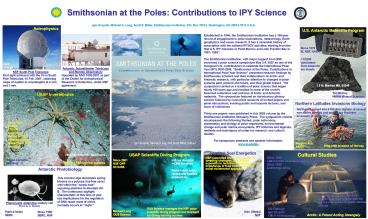Smithsonian at the Poles: Contributions to IPY Science - PowerPoint PPT Presentation
Title:
Smithsonian at the Poles: Contributions to IPY Science
Description:
Smithsonian at the Poles: Contributions to IPY Science Astrophysics U.S. Antarctic Meteorite Program Igor Krupnik, Michael A. Lang, Scott E. Miller, Smithsonian ... – PowerPoint PPT presentation
Number of Views:54
Avg rating:3.0/5.0
Title: Smithsonian at the Poles: Contributions to IPY Science
1
Smithsonian at the Poles Contributions to IPY
Science
Astrophysics
U.S. Antarctic Meteorite Program
Igor Krupnik, Michael A. Lang, Scott E. Miller,
Smithsonian Institution, P.O. Box 37012,
Washington, DC 20013-7012 U.S.A.
Established in 1846, the Smithsonian Institution
has a 160-year record of engagement in polar
explorations, meteorology, Earth geophysics and
ocean research. It has a venerable history of
association with the national IPY/IGY activities,
starting from the first U.S. IPY missions to
Point Barrow and Lady Franklin Bay in 1881-
1884. The Smithsonian Institution, with major
support from NSF, convened a polar science
symposium May 3-4, 2007 as one of the inaugural
U.S. contributions to celebrate the International
Polar Year (IPY) 2007-2008. Smithsonian at the
Poles Contributions to International Polar Year
Science" presented research findings by
Smithsonian scholars and their collaborators on
Arctic and Antarctic research, with particular
attention to changes in polar systems past,
present and future, and their global impact. The
symposium carried on a tradition of polar science
that began nearly 160 years ago and resulted in
some of the worlds foremost collections and
archives of Arctic and Antarctic materials. The
symposium featured an introductory plenary
session followed by concurrent sessions of
invited papers and panel discussions, evening
public and keynote lectures, and tours of
collections. Thirty one papers were published
in this 2009 volume by the Smithsonian
Institution Scholarly Press. The symposium
volume encompasses the following themes polar
astronomy, systematics and biology of polar
organisms, environmental change and polar marine
ecosystems, IPY histories and legacies, methods
and techniques of under-ice research, and
cultural studies. For symposium abstracts and
speaker information www.si.edu/ipy
Since 1976 SI, NSF, NASA
gt12,000 specimens from Antarctic ice sheets
dark energy
Antarctic Submillimeter Telescope and Remote
Observatory Operated by SAO 1995-2007 as part of
the Center for Astrophysical Research in
Antarctica, under NSF agreement.
NSF South Pole Telescope First light achieved
with the 10-m South Pole Telescope, 16 Feb. 2007,
obtaining maps of Jupiter at wavelengths at 2 mm
and 3 mm.
1.5 lb. Martian MIL 03346
USAP Invertebrates
Tim McCoy NMNH Mineral Sciences
Northern Latitudes Invasions Biology
Northward spread into 6 Alaskan regions of
several non-native species and increasing
Southern invasions of Antarctica
Since 1995 SI, NSF 170,000 specimens loaned in
138 separate lots to researchers in 22 countries
Gregory Ruiz SERC
King crab invasion of Norway
Weddell Seal Energetics
USAP Scientific Diving Program
Cultural Studies
gt900,000 Antarctic specimens
Since 1988 NMNH Arctic Studies Center Since
1995 Anchorage office
NSF-supported study of evolution of breeding
strategies, seal capital expenditure, lactation
energetics and the importance of food intake
through a novel multimarker approach.
Rafael Lemaitre NMNH IZ
Since 2001 NSF OPP SI OUSS
gt30 ice divers/yr gt4,800 ice dives Remarkable
safety record and science productivity
Palmer LTER archival samples
Antarctic Photobiology
This colonial alga dominates spring blooms in a
polynya (ice-free zone) well within the "ozone
hole" exposing plankton to elevated UV-B. The
continuous daylight characteristic of this time
of year has implications for the regulation of
DNA repair most of which normally occurs at
night.
Cultural heritage studies and indigenous
knowledge of sea ice, marine mammals and Arctic
climate change
Phaeocystis antarctica solitary cell Photo by A.
Shields
OUS Science manages the NSF polar scientific
diving program and Svalbard ice diving training
courses
Bill Fitzhugh Igor Krupnik NMNH Anthropology
Michael Lang OUS Science
Patrick Neale SERC
Olav Oftedal NZP
Since 1990 SERC, NSF
Arctic A Friend Acting Strangely































